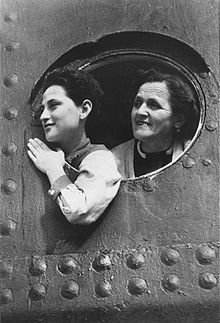Porthole

A porthole is a small, generally circular, window used on the hull of ships to admit light and air. Porthole is actually an abbreviated term for "port hole window". Though the term is of obvious maritime origin, it is also used to describe round windows on armored vehicles, aircraft, automobiles (the Ford Thunderbird a notable example), and even spacecraft.
On a ship, the function of a porthole, when open, is to permit light and fresh air to enter the dark and often damp below-deck quarters of the vessel. It also affords below-deck occupants a limited, but often much needed view to the outside world. When closed, the porthole provides a strong water-tight, weather-tight, and sometimes light-tight barrier.
A porthole on a ship may also be called a sidescuttle or side scuttle (side hole). This term is used in the U.S. Code of Federal Regulations. It is also used in related rules and regulations for the construction of ships. The use of the word "sidescuttle" instead of "porthole" is meant to be broad, including any covered or uncovered hole in the side of the vessel.
Structure

A porthole consists of at least two structural components and is, in its simplest form, similar to any other type of window in design and purpose. The porthole is primarily a circular glass disk encased in a metal frame that is bolted securely into the side of a ship's hull. Sometimes the glass disk of a porthole is encased in a separate frame which is hinged onto the base frame so that it can be opened and closed. In addition, many portholes also have metal storm covers that can be securely fastened against the window when necessary. The main purpose of the storm cover is, as its name implies, to protect the window from heavy seas. It is also used to block light from entering lower berths when darkness is preferred. Storm covers are also used on Navy and merchant marine ships to prevent interior light from escaping the ship's lower berths, and to provide protection from hostile fire. Hinged porthole windows and storm covers are accessible from inside the ship's hull, and are typically fastened to their closed positions by hand tightening several pivoting, threaded devices, commonly referred to as "dogs." Older portholes can be identified by the protruding collar of their base plate which may be up to several inches deep, thus accommodating the thickness of a wooden hull.
Portholes range in diameter from several inches to more than two feet, and weigh from several pounds to over one hundred pounds. Much of the porthole's weight comes from its glass, which, on ships, can be as much as two inches thick. Metal components of a porthole are also typically very heavy; they are usually sand-cast and made of bronze, brass, steel, iron, or aluminium. Bronze and brass are most commonly used, favoured for their resistance to saltwater corrosion. The design of the porthole is such that it achieves its humble purposes without sacrificing the integrity of the ship's hull. The porthole's thick glass and rugged construction, tightly spaced fasteners, indeed even its round shape, all contribute to its purpose of maintaining hull strength.
Spacecraft portholes

Portholes on spacecraft must be made from glass that can survive rapid temperature changes, without suffering the cracking that can result from thermal shock. Those on the International Space Station were made from quartz glass mounted on titanium frames, covered with enamel.
On the Apollo space capsules a porthole was located in the hatch that the astronauts used at the beginning and end of each flight.
Submarine portholes
Portholes on submarines are generally made of acrylic plastic. In the case of deep diving submarines, the portholes can be several inches thick. The edge of the acrylic is usually conically tapered such that the external pressure forces the acrylic window against the seat. Usually such windows are flat rather than spherically dished. This decreases the area that can be viewed, but eliminates distortion associated with curved glass.
See also
References
Title 46 U.S. Code of Federal Regulations Sec. 45.139 - Side scuttles.
